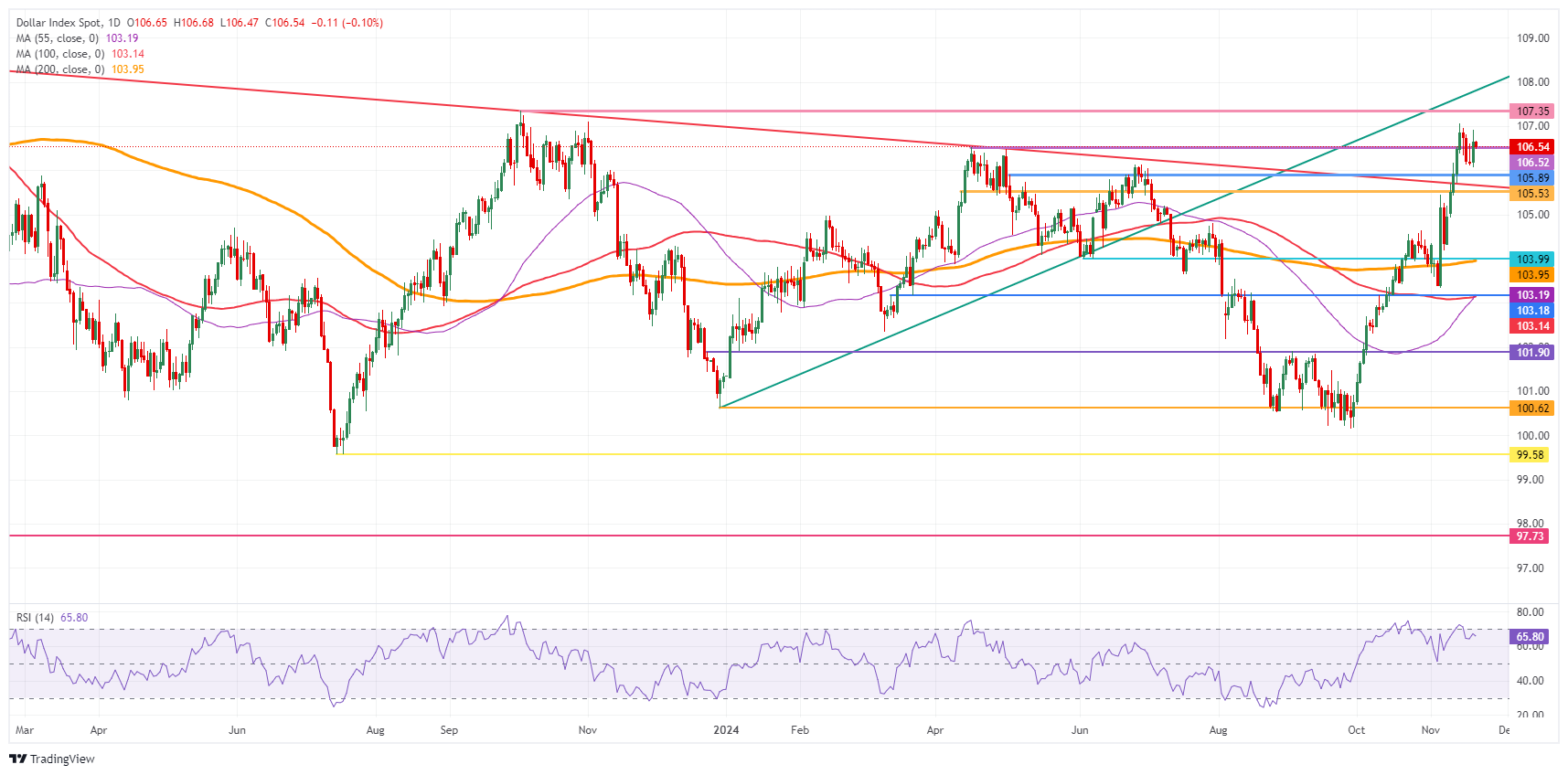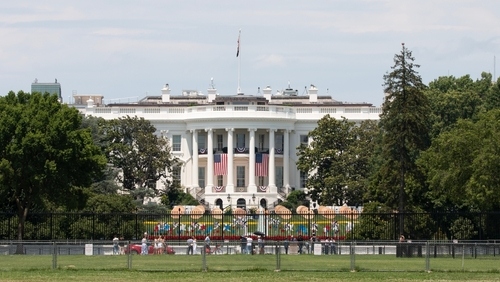US Dollar flattens after Fed’s Williams delivers dovish comments

- The US Dollar flattens on Thursday after Fed’s Williams said he sees inflation cooling and interest rates falling.
- Investors will look at Jobless Claims data and further comments from Fed officials.
- The US Dollar Index trades flat around 106.50, still looking for support to bounce off from.
The US Dollar (USD) is trading flat on Thursday at around 106.50 when tracked by the DXY US Dollar Index, afterNew York Fed President John Williams said that inflation continues to cool down, opening the door for a further drop in interest rates. The US Dollar has traded broadly sideways in recent days, influenced by swings coming from the war between Russia and Ukraine and, more recently, disappointing earnings from Nvidia.
The US economic calendar features on Thursday the weekly Jobless Claims data and the Philadelphia Fed Manufacturing Survey for November, which will be a good leading indicator of how the sector is responding to President-elect Donald Trump’s victory. Moreover, four other Fed speakers are set to make comments today.
Daily digest market movers: Walking through a pothole-filled Thursday
- New York Fed President John Willams delivered some dovish comments.Williams said that inflation is heading lower and interest rates should fall further.
- Fed’s Williams meanwhile received additional support from Richmond Fed President Tom Barkin who said in an interview on Thursday with the Financial Times that inflation will continue to drop, Bloomberg reports.
- On the geopolitical front, Ukraine reports that Russia has launched a ballistic missile, Bloomberg reports.
- At 13:30 GMT, the Weekly Jobless Claims for the week ending November 15 are due. Expectations are for a small uptick to 220,000 against the 217,000 from the week before.
- The Philadelphia Fed Manufacturing Survey for November is expected to decline to 8 coming from 10.3.
- Existing Home Sales data for October are due at 15:00 GMT. Economists expect sales to jump higher to 3.93 million from 3.84 million in September.
- A batch of Fed speakers are due this Thursday:
- Near 13:45 GMT, Federal Reserve Bank of Cleveland President Beth Hammack delivers welcome remarks at the 2024 Financial Stability Conference organized by the Cleveland Fed. Hammack will speak again at 17:30 GMT at the same event.
- At 17:25 GMT, Federal Reserve Bank of Chicago President Austan Goolsbee participates in a moderated Q&A session at an event organized by the Central Indiana Corporate Partnership in Indianapolis.
- Federal Reserve Bank of Kansas City President Jeffrey Schmid delivers a speech about economic growth and monetary policy at an event organized by the Fairfax Industrial Association in Kansas City at 17:40 GMT.
- Federal Reserve Vice Chair for Supervision Michael Barr closes off at 21:40 GMT, participating in a discussion about banks and artificial intelligence at the 2024 FinRegLab AI Symposium in Washington DC.
- Equities are torn between the dovish comments from Fed’s Williams, while the ballistic missile launch from Russia to Ukraine is triggering safe-haven flows. In this context, equities are looking for direction.
- The CME FedWatch Tool is pricing in another 25 basis points (bps) rate cut by the Fed at the December 18 meeting by 55.5%. A 44.5% chance is for rates to remain unchanged. While the interest-rate cut scenario is still the most probable, traders have significantly pared back some of the rate-cut bets compared with a week ago, when a rate-cut possibility was still at 72%.
- The US 10-year benchmark rate trades at 4.40%, sliding further away from the high printed on Friday at 4.50%.
US Dollar Index Technical Analysis: Risks at hand
The US Dollar Index (DXY) is supported by the constant safe-haven inflow on the geopolitical tensions escalating between Russia and Ukraine. Traders should keep in mind that if the recent escalation eases and both parties head into any kind of ceasefire talks, the Greenback could retreat.
After a brief test and a firm rejection last Thursday, the 107.00 round level remains in play on the topside. A fresh yearly high has already been reached at 107.07, which is the statistical level to beat. Further up, a fresh two-year high could be reached if 107.35 is broken.
The first level on the downside is 105.93, the closing from November 12. A touch lower, the pivotal 105.53 (April 11 high) should avoid any downturns towards 104.00. Should the DXY fall all the way towards 104.00, the big figure and the 200-day Simple Moving Average at 103.95 should catch any falling knive formation.

US Dollar Index: Daily Chart
US Dollar FAQs
The US Dollar (USD) is the official currency of the United States of America, and the ‘de facto’ currency of a significant number of other countries where it is found in circulation alongside local notes. It is the most heavily traded currency in the world, accounting for over 88% of all global foreign exchange turnover, or an average of $6.6 trillion in transactions per day, according to data from 2022. Following the second world war, the USD took over from the British Pound as the world’s reserve currency. For most of its history, the US Dollar was backed by Gold, until the Bretton Woods Agreement in 1971 when the Gold Standard went away.
The most important single factor impacting on the value of the US Dollar is monetary policy, which is shaped by the Federal Reserve (Fed). The Fed has two mandates: to achieve price stability (control inflation) and foster full employment. Its primary tool to achieve these two goals is by adjusting interest rates. When prices are rising too quickly and inflation is above the Fed’s 2% target, the Fed will raise rates, which helps the USD value. When inflation falls below 2% or the Unemployment Rate is too high, the Fed may lower interest rates, which weighs on the Greenback.
In extreme situations, the Federal Reserve can also print more Dollars and enact quantitative easing (QE). QE is the process by which the Fed substantially increases the flow of credit in a stuck financial system. It is a non-standard policy measure used when credit has dried up because banks will not lend to each other (out of the fear of counterparty default). It is a last resort when simply lowering interest rates is unlikely to achieve the necessary result. It was the Fed’s weapon of choice to combat the credit crunch that occurred during the Great Financial Crisis in 2008. It involves the Fed printing more Dollars and using them to buy US government bonds predominantly from financial institutions. QE usually leads to a weaker US Dollar.
Quantitative tightening (QT) is the reverse process whereby the Federal Reserve stops buying bonds from financial institutions and does not reinvest the principal from the bonds it holds maturing in new purchases. It is usually positive for the US Dollar.




